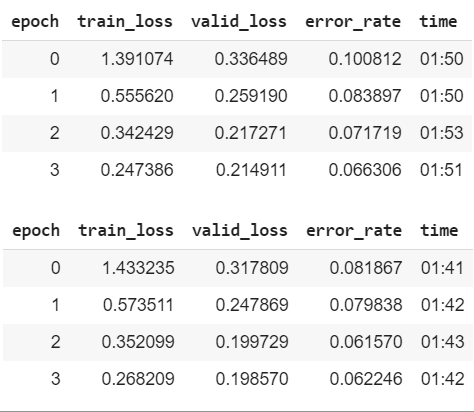Hi ,
Thank you for your help,
This is my problem::
OSError Traceback (most recent call last)
in
----> 1 learn.fit_one_cycle(4)
~/anaconda3/lib/python3.7/site-packages/fastai/train.py in fit_one_cycle(learn, cyc_len, max_lr, moms, div_factor, pct_start, final_div, wd, callbacks, tot_epochs, start_epoch)
20 callbacks.append(OneCycleScheduler(learn, max_lr, moms=moms, div_factor=div_factor, pct_start=pct_start,
21 final_div=final_div, tot_epochs=tot_epochs, start_epoch=start_epoch))
—> 22 learn.fit(cyc_len, max_lr, wd=wd, callbacks=callbacks)
23
24 def lr_find(learn:Learner, start_lr:Floats=1e-7, end_lr:Floats=10, num_it:int=100, stop_div:bool=True, wd:float=None):
~/anaconda3/lib/python3.7/site-packages/fastai/basic_train.py in fit(self, epochs, lr, wd, callbacks)
198 callbacks = [cb(self) for cb in self.callback_fns + listify(defaults.extra_callback_fns)] + listify(callbacks)
199 if defaults.extra_callbacks is not None: callbacks += defaults.extra_callbacks
–> 200 fit(epochs, self, metrics=self.metrics, callbacks=self.callbacks+callbacks)
201
202 def create_opt(self, lr:Floats, wd:Floats=0.)->None:
~/anaconda3/lib/python3.7/site-packages/fastai/basic_train.py in fit(epochs, learn, callbacks, metrics)
104 if not cb_handler.skip_validate and not learn.data.empty_val:
105 val_loss = validate(learn.model, learn.data.valid_dl, loss_func=learn.loss_func,
–> 106 cb_handler=cb_handler, pbar=pbar)
107 else: val_loss=None
108 if cb_handler.on_epoch_end(val_loss): break
~/anaconda3/lib/python3.7/site-packages/fastai/basic_train.py in validate(model, dl, loss_func, cb_handler, pbar, average, n_batch)
55 val_losses,nums = [],[]
56 if cb_handler: cb_handler.set_dl(dl)
—> 57 for xb,yb in progress_bar(dl, parent=pbar, leave=(pbar is not None)):
58 if cb_handler: xb, yb = cb_handler.on_batch_begin(xb, yb, train=False)
59 val_loss = loss_batch(model, xb, yb, loss_func, cb_handler=cb_handler)
~/anaconda3/lib/python3.7/site-packages/fastprogress/fastprogress.py in iter(self)
70 self.update(0)
71 try:
—> 72 for i,o in enumerate(self._gen):
73 if i >= self.total: break
74 yield o
~/anaconda3/lib/python3.7/site-packages/fastai/basic_data.py in iter(self)
73 def iter(self):
74 “Process and returns items from DataLoader.”
—> 75 for b in self.dl: yield self.proc_batch(b)
76
77 @classmethod
~/anaconda3/lib/python3.7/site-packages/torch/utils/data/dataloader.py in iter(self)
191
192 def iter(self):
–> 193 return _DataLoaderIter(self)
194
195 def len(self):
~/anaconda3/lib/python3.7/site-packages/torch/utils/data/dataloader.py in init(self, loader)
467 # before it starts, and del tries to join but will get:
468 # AssertionError: can only join a started process.
–> 469 w.start()
470 self.index_queues.append(index_queue)
471 self.workers.append(w)
~/anaconda3/lib/python3.7/multiprocessing/process.py in start(self)
110 ‘daemonic processes are not allowed to have children’
111 _cleanup()
–> 112 self._popen = self._Popen(self)
113 self._sentinel = self._popen.sentinel
114 # Avoid a refcycle if the target function holds an indirect
~/anaconda3/lib/python3.7/multiprocessing/context.py in _Popen(process_obj)
221 @staticmethod
222 def _Popen(process_obj):
–> 223 return _default_context.get_context().Process._Popen(process_obj)
224
225 class DefaultContext(BaseContext):
~/anaconda3/lib/python3.7/multiprocessing/context.py in _Popen(process_obj)
275 def _Popen(process_obj):
276 from .popen_fork import Popen
–> 277 return Popen(process_obj)
278
279 class SpawnProcess(process.BaseProcess):
~/anaconda3/lib/python3.7/multiprocessing/popen_fork.py in init(self, process_obj)
18 self.returncode = None
19 self.finalizer = None
—> 20 self._launch(process_obj)
21
22 def duplicate_for_child(self, fd):
~/anaconda3/lib/python3.7/multiprocessing/popen_fork.py in _launch(self, process_obj)
68 code = 1
69 parent_r, child_w = os.pipe()
—> 70 self.pid = os.fork()
71 if self.pid == 0:
72 try:
OSError: [Errno 22] Invalid argument


